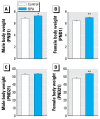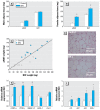Perinatal exposure to bisphenol a alters early adipogenesis in the rat
- PMID: 20019905
- PMCID: PMC2790509
- DOI: 10.1289/ehp.11342
Perinatal exposure to bisphenol a alters early adipogenesis in the rat
Abstract
Background: The causes of the current obesity pandemic have not been fully elucidated. Implication of environmental endocrine disruptors such as bisphenol A (BPA) on adipose tissue development has been poorly investigated.
Objectives: The aim of the present study was to evaluate the effects of perinatal exposure to BPA on early adipose storage at weaning.
Methods: Pregnant Sprague-Dawley rats had access to drinking water containing 1 mg/L BPA from day 6 of gestation through the end of lactation. Pups were weaned on postnatal day (PND) 21. At that time, we investigated perigonadal adipose tissue of pups (weight, histology, gene expression). For the remaining animals, we recorded body weight and food intake for animals on either standard chow or a high-fat diet.
Results: Gestational exposure to BPA did not alter the sex ratio or litter size at birth. On PND1, the weight of male and female BPA-exposed pups was increased. On PND21, body weight was increased only in females, in which parametrial white adipose tissue (pWAT) weight was increased about 3-fold. This excess of pWAT was associated with adipocyte hypertrophy and overexpression of lipogenic genes such as C/EBP-alpha (CAAT enhancer binding protein alpha), PPAR-gamma (peroxisome proliferator-activated receptor gamma), SREBP-1C (sterol regulatory element binding protein-1C), LPL (lipoprotein lipase), FAS (fatty acid synthase), and SCD-1 (stearoyl-CoA desaturase 1). In addition, gene expression of SREBP-1C, FAS, and ACC (acetyl-CoA carboxylase) was also increased in liver from BPA-exposed females at PND21, without a change in circulating lipids and glucose. After weaning, perinatal BPA exposure predisposed to overweight in a sex- and diet-dependent manner. We observed no change in food intake due to perinatal BPA exposure in rats on either standard chow or a high-fat diet.
Conclusions: Perinatal exposure to a low dose of BPA increased adipogenesis in females at weaning. Adult body weight may be programmed during early life, leading to changes dependent on the sex and the nutritional status. Although further studies are required to understand the mechanisms of BPA action in early life, these results are particularly important with regard to the increasing prevalence of childhood obesity and the context-dependent action of endocrine disruptors.
Keywords: adipocyte; adipose tissue; bisphenol A; food intake; obesity.
Figures




References
-
- Ailhaud G. Adipose Tissue Protocols Methods in Molecular Biology. Vol. 155. Totowa, NJ: Humana Press; 2001.
-
- Aloisi AM, Della Seta D, Rendo C, Ceccarelli I, Scaramuzzino A, Farabollini F. Exposure to the estrogenic pollutant bisphenol A affects pain behavior induced by subcutaneous formalin injection in male and female rats. Brain Res. 2002;937(1–2):1–7. - PubMed
-
- Chapin RE, Adams J, Boekelheide K, Gray LE, Jr, Hayward SW, Lees PS, et al. NTP-CERHR expert panel report on the reproductive and developmental toxicity of bisphenol A. Birth Defects Res B Dev Reprod Toxicol. 2008;83(3):157–395. - PubMed
-
- Della Seta D, Minder I, Dessi-Fulgheri F, Farabollini F. Bisphenol-A exposure during pregnancy and lactation affects maternal behavior in rats. Brain Res Bull. 2005;65(3):255–260. - PubMed
Publication types
MeSH terms
Substances
LinkOut - more resources
Full Text Sources
Research Materials
Miscellaneous

